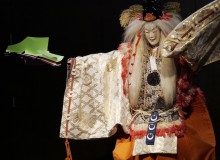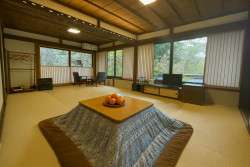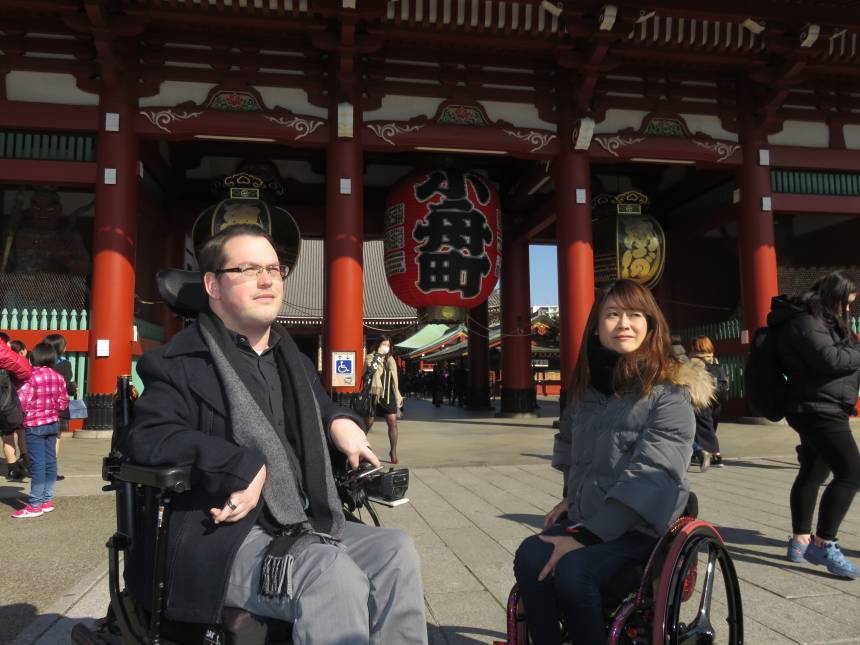
April 8, 2017
Accessible Tokyo Travel: A Wheelchair User’s Guide to Navigating the City
Tokyo barrier-free touring
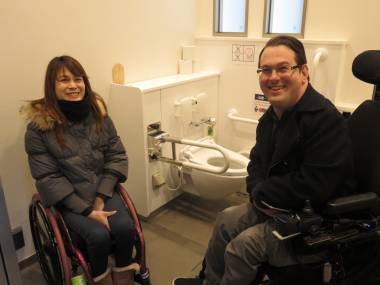
Josh Grisdale peers into the accessible bathroom at the Asakusa Culture and Tourism Center and shakes his head. “I couldn’t use this.” In this feature, we aim to answer the question: how accessible is travel in Tokyo?
Wheelchair Accessibility in Tokyo: The Reality
We are here at the start of a barrier-free tour of Tokyo arranged by Trip Designer, a company specializing in tours catering to foreign visitors. Our mission is to travel around two major tourist areas of Tokyo—Asakusa and Harajuku/Shibuya—using only public transport, while moving at the pace of two wheelchair users.
Grisdale, who originally hails from Canada, runs the Accessible Japan website for those visiting and living in Japan with disabilities. As someone coping with the challenges of cerebral palsy, he knows firsthand about navigating the city in his wheelchair.
Joining Grisdale as a guinea pig is Japanese athlete Kazumi Nakayama, who holds several national records in women’s wheelchair racing. After suffering a spinal stroke in her early 20s that led to paraplegia, Nakayama rose to prominence as a wheelchair racer and went on to represent Japan at the 2016 Rio Paralympics.
Visiting Sensoji Temple in a Wheelchair
To my untrained eye, the Asakusa Culture and Tourism Center bathroom seems to check all the boxes: It is wide enough for wheelchairs or strollers to enter, including with a caregiver, and is equipped with handrails, an emergency call button, and a sink to allow for the cleaning of ostomy bags (prosthetic devices that collect body waste for people who have undergone surgeries such as colostomies.) However, Grisdale points out that the toilet lacks a backrest, which means he can’t use it safely.
Grisdale otherwise praises the overall standard of Japan’s disabled toilets. “The concept of the ‘dare demo toire’ (everyone’s toilet), for example, is terrific. People can use the facility irrespective of gender, and the elderly or those with small children benefit, too.” However, features can vary. “It would be great to have a national standard for accessible bathrooms, so that people know exactly what to expect,” Grisdale says.
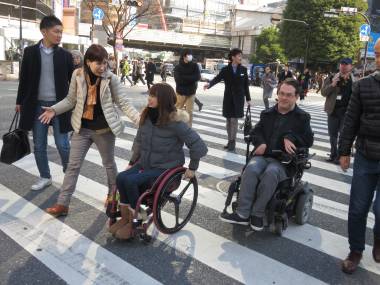
Our group heads down the Nakamise shopping street that leads to Sensoji Temple. Though crowds are still relatively light, foreign tourists and Japanese alike occasionally cut through the middle of our group, showing little regard for Grisdale and Nakayama rolling along side by side.
The guides point out a street running parallel to the Nakamise, which can be used when the main route is too crowded—less exciting, perhaps, but infinitely safer for those with mobility issues. We also learn that shopkeepers are more than happy to bring out wares to show to wheelchair users who can’t gain entry into the tiny narrow stores.
The Hidden Barriers in “Barrier-Free” Design
I was wondering how Grisdale and Nakayama would enter the grounds at Sensoji, but where there’s a will, there’s a way: Although not immediately apparent, there is an unobtrusive slope off to the side of the temple which allows wheelchair users to access an elevator up to the main area of the building.
“They’ve done a good job of making the temple barrier-free without detracting from the overall atmosphere,” notes guide Shizuko Tada. Grisdale agrees, but points out that the signs for the barrier-free route are hard to spot. And with the rise in foreign tourists, adding an explanation in other languages would be a good step. “That’s another issue that needs to be better addressed—making sure that people know about, and can easily find, the services and facilities available for those with disabilities,” he says.
Using Public Transport with a Disability in Tokyo
At the station, Nakayama and Grisdale demonstrate how the obliging station staff help get them down to the platform, after they had called ahead to the destination station. After lunch, at Shibuya Station, we get a bird’s eye view of the famous Shibuya scramble crossing from windows near the Keio Inokashira Line entrance, conveniently set low so that even wheelchair users or children in strollers can see the hustle and bustle below. The tour concludes with a leisurely stroll and roll down Omotesando.
Tokyo vs. Rio: Cultural Attitudes Toward Disability
Comparing her experiences in Rio and Tokyo, Nakayama says, “In general, Japan’s facilities are much better but the people in Rio were extremely friendly and obliging, asking if you need help. I think that is one area where Tokyo could improve. It isn’t just about improving facilities, it is about changing people’s way of thinking, too.”
Overall, Grisdale and Nakayama are impressed and give the tour two thumbs up each. While there are areas for improvement ahead of the 2020 Paralympics, Tokyo is clearly a lot more accessible than might be commonly thought. Tada, the tour guide, said she had certainly learned a thing or two. “I’ve guided disabled people round Tokyo before but always by using a taxi service. I am quite surprised that it’s entirely possible to do a day of touring using public transport.”
What Needs to Improve Before Tokyo Becomes Truly Accessible for Travel
Trip Designer CEO Takeshi Sakamoto put together the tour in consultation with Grisdale, and hopes to start offering similar ones around Japan. “I know that only visiting two major tourist areas is one day probably doesn’t seem like much to the average tourist, but it is a start. It shows that tourists with disabilities can come and enjoy this city,” he says.
Grisdale agrees wholeheartedly. “Tokyo really has a chance to really put itself on the map as a barrier-free destination. It’s a win-win situation for both foreign tourists and the local economy.”
Accessible Japan’s website: www.accessible-japan.com
